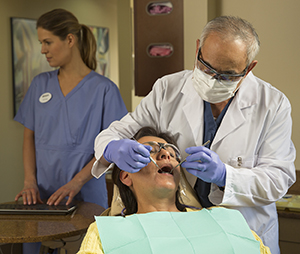A
B
C
D
E
F
G
H
I
J
K
L
M
N
O
P
Q
R
S
T
U
V
W
X
Y
Z
Topic IndexLibrary Index
Click a letter to see a list of conditions beginning with that letter.
Click 'Topic Index' to return to the index for the current topic.
Click 'Library Index' to return to the listing of all topics.
Your Dental Visit
Visit the dental office every 6 months. During your visit, your dental provider will make sure your teeth and gums are healthy. Your dentist or dental hygienist will advise self-care and treatment if problems are found.

Your health history
Since oral health is linked to general health, your visit will likely start with a health history. Tell your dental provider if you have health conditions or allergies. Also tell them if you've had surgeries. Tell them about any medicines you take, including prescriptions, over-the-counter medicines, and supplements. Also tell them about any illegal drugs you use. You may be asked about your daily tooth and gum care. Tell your dental provider if you grind your teeth or often breathe through your mouth. You should also bring up any oral health issues that concern you.
Your dental assessment
Your dentist or dental hygienist may start by screening for oral cancer. This includes feeling your neck and throat and looking inside your mouth. Then your dental provider will:
-
Examine your teeth. If you have any tooth decay, chips, cracks or fractures, it will be marked on your dental record. Notes will also be made about any existing restorations. This includes fillings, crowns, bridges, implants, or dentures.
-
Examine your gums. A special instrument called a periodontal probe is used to measure pocket depths around all the teeth. Deep pockets could mean a problem. Your dentist or hygienist will also check for areas of swelling, redness, bleeding, and gums pulled away from teeth (recession). These are all signs of gum disease.
-
Take X-rays, pictures, and molds of the teeth (impressions), if needed. These will be put in your record so your dentist or dental hygienist can refer to them at your next visit. This helps keep track of any changes to your mouth over time.
Finishing up
Depending on what your dental provider finds, the rest of your visit may include:
-
A cleaning. This helps prevent gum disease. Your dental provider will clean above and slightly below the gumline. This is where your toothbrush and floss can’t reach.
-
A cosmetic polishing. This removes stains on the surfaces of your teeth.
-
More assessment and treatment. Your dental provider will talk about any problems that are found. You may need to see a specialist.
-
Home care instructions. Your dental provider will tell you how to give your teeth and gums the best care at home. They will likely provide you with supplies, such as a toothbrush, toothpaste, and floss.
Online Medical Reviewer:
Jessica Gotwals RN BSN MPH
Online Medical Reviewer:
Michael Kapner MD
Online Medical Reviewer:
Tennille Dozier RN BSN RDMS
Date Last Reviewed:
5/1/2022
© 2000-2024 The StayWell Company, LLC. All rights reserved. This information is not intended as a substitute for professional medical care. Always follow your healthcare professional's instructions.